A Loving Eye for Detail
Our third trip takes us to Les Bioux in the Vallée de Joux, to the Poncet family’s alpine cheese dairy La Duchatte. Here, they demonstrate that is also possible to make outstanding soft cheeses from raw milk.
Our third trip takes us to Les Bioux in the Vallée de Joux, to the Poncet family’s alpine cheese dairy La Duchatte. Here, they demonstrate that is also possible to make outstanding soft cheeses from raw milk.
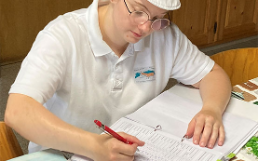
Making soft cheese from raw milk requires the application of very high standards to the premises, raw materials and way of working. In 1970 the Poncet family took over the running of Alp La Duchatte, switched over from the production of Gruyère d’Alpage to Tommes, and applied these high standards to the potential offered by an alpine cheese dairy, to impressive effect. Scientific and technical support for this endeavour were provided by the regional extension advisor from Arqha and the national extension advisor from Agroscope. A constructive dialogue was also established with the Cantonal Enforcement Authority. The open exchange of experience with other producers of raw-milk soft cheeses has also been key for success.
When producing soft cheese from raw milk, the essential thing is to have the entire production process as well under control as possible, since end-product inspections quickly become prohibitively expensive for small-and-smallest businesses. Systematic recording of the production dates and day-to-day observations are important tools for the rapid detection of abnormalities.
The entire Poncet family – father Guillaume, mother Nathalie, daughter Élodie and son Damien – as well as employee Natalia Kinga Walczak from Poland, are fully aware of how high the standards are which they have clearly taken on board, heart and soul.
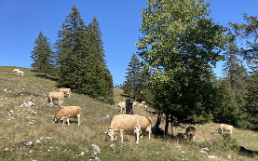
The Poncet family swears by purebred Simmental cows. Though not high-yielding cows, they are ideally suited to alpine farming. In their breeding, great importance is always attached to health, robustness and temperament. Simmentals are also a so-called dual-use breed, since the quality of their meat is good – an obvious plus with the current challenges of sustainable livestock production. The milk of Simmental cows is characterised by its high protein and fat content, and is ideal for cheese production.
Having observed that it may be more difficult to make cheese from the milk of cows in oestrus, Guillaume Poncet decided that only cows in calf would be summered on Alp La Duchatte. Here too, we can see the systematic effort to keep the entire process as much under control as possible.
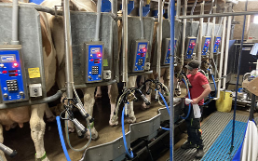
It’s surprising to find such a modern 8-unit milking parlour on an alp and it’s striking how clean and dry it is everywhere. The cows are very clean when they come for milking, since there is no boggy ground around the alpine hut. Their teats are cleaned with a damp cloth before the teatcups are attached. Teat-dipping in a disinfection solution is deliberately forgone, however, so as not to destroy desirable microflora. The clear separation of the milking and processing processes is exemplary. When moving from one area to the other, clothes and shoes are changed as a matter of course.
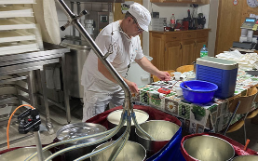
Cheese dairies are normally quite noisy places. Not so on the Alp La Duchatte. There’s not a single machine that might disturb the calm. The milk flows silently from the milking parlour through a pipe with a natural gradient into the cheese dairy and is distributed via an ingenious system among the 8 kettles to produce a mix of the various milkings. Prior to this, a proportion of the previous evening’s milk stored overnight at 10 °C had been distributed between the kettles. A substantial percentage of the evening milk is pasteurised and sold as full-fat milk or yoghurt, however.
In addition to the quiet, one is struck by the very calm, deliberate and focused way in which the entire family works.
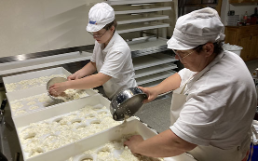
To keep well on top of the entire production process, the cheesemakers work with 8 small kettles instead of one large vat. The process is optimally coordinated, and there would have to be a very compelling reason to change it in any way.
Um die ganze Herstellung gut im Griff zu haben, wird mit 8 kleinen Kesseln statt mit einer grossen Wanne gearbeitet. Der Ablauf ist bestens eingespielt und es braucht sehr starke Gründe, um etwas daran zu ändern.Fresh yoghurt is added to kick off lactic-acid fermentation. An additional thermophilic starter culture ensures a stable acidification process.
The curd is cut with a flattened metal rod (narrow edge), then gently stirred (wide edge) (Link to video). An important signature feature is that the cheese curd is scooped by hand into the draining moulds. When the whey draining off runs clear and the curd granules coalesce quickly, this is strong evidence of successful production and active lactic-acid fermentation. During the draining process the cheeses are flipped twice.
An impressive tidiness and cleanliness prevails on the entire alp, which is equipped in an extremely functional manner. Everything has its place and is cleaned and tidied away after use. There is nothing superflous lying around. Before all contact with food, the cheesemakers wash and disinfect their hands.
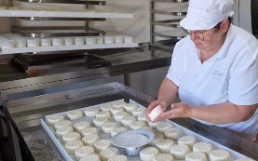
As soon as the lactic-acid fermentation – measured by the pH level – is sufficiently advanced, the Tommes are removed from their moulds and rubbed on both sides with salt. A great deal of experience and a sure instinct are required to achieve the desired salt content. Timing is also crucial, since salting puts an end to lactic-acid fermentation and causes the formation of a rind that reduces whey drainage. A major advantage of dry-salting over immersion in a salt bath is that it can help prevent possible infection with undesirable foreign microorganisms. (Photo 3718)
On the day of our visit, 541 tommes were made. By the end of the Alp season, the figure will have risen to over 70,000.
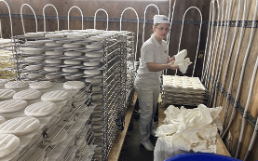
The Tommes are ripened at around 17 °C at a relative humidity of over 90% for one week, during which time they are turned regularly to allow the formation of an even bloomy rind. Initially the cheeses are placed on a linen cloth to aid drying and to prevent whey dripping on the cheeses below. Each time the cheeses are turned the linen cloths are changed and the used ones washed. After a week, a fine, even bloomy rind has developed on the Tommes. The cheeses can now be packaged, then further ripened in the cold store at 4 °C. They are best eaten within a month.
Interestingly, it is not a mould that is responsible for the bloomy rind covering the cheese, as with e.g. Penicillum camemberti for Camembert. With Tommes, Geotrichum candidum is added to the milk for rind formation. Taxonomically a yeast, Geotrichum candidum breaks down the lactic acid in cheese like Penicillum does, but forms a considerably finer bloomy rind than the latter.
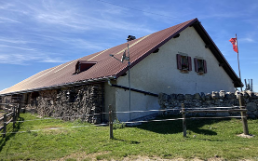
The five cousins of the extended Poncet family – the sons of four brothers – together run a savvy farming collective, as part of which they stock three seasonal mountain pastures with cows. On Alp La Duchatte, only cows that are in calf are summered. Young cattle are summered on Alp La Racine and the largest herd is on Alp La Poyette, where Le Gruyère d’Alpage AOP is produced. The Poncet families also fatten pigs, so that the whey by-product can be fed directly to pigs on the two alps with cheese dairies.
Products of exceptional quality and a large number of loyal customers are two key pillars of their successful marketing, primarily within the Canton of Vaud.
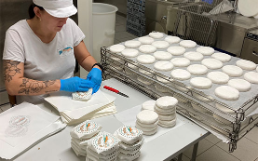
La Duchatte Tommes will wow you with their beautiful, super-creamy consistency. The cheeses melt wonderfully on the palate, leaving many commercials for French soft cheeses looking rather old-hat.
The fresh mountain milk is surprisingly to the fore in the aroma. The pleasure lifts the spirits, like a hike in the Jura mountains with a backdrop of grazing cows. In addition to the characteristic mushroomy note, you’ll also get pops of citrusy flavours. The yoghurt culture lends an agreeable freshness. The milky-buttery notes provide ample harmony in the rather short finish.
Guillaume Poncet’s preferred accompaniment to his Tommes is a glass of red wine, so we’ve decided to choose a selection of new and traditional reds from Agroscope’s research for the «mariages» or pairings. We divided the red wines into three groups:
Last modification 09.11.2023